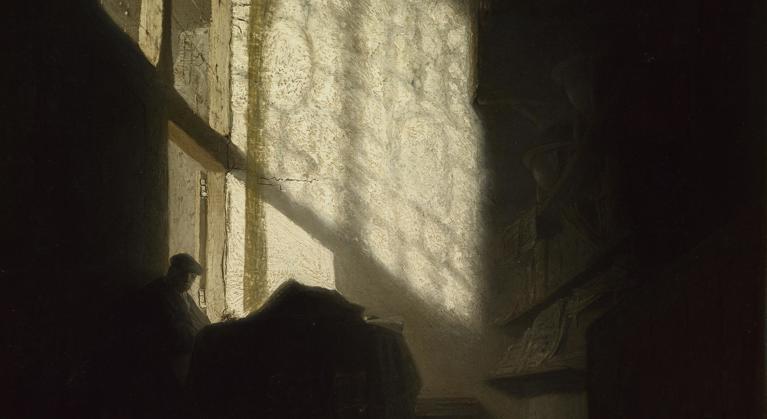About
This four-week course looks at how the use, depiction and symbolism of light evolved in western European painting. The course begins with the application and symbolism of gold and gilding in early Renaissance paintings and explores how this evolved into the illusionistic use of paint to depict light and reflections.
We will also consider how the representation of light was historically used as a metaphor for sight and creation, and how it became key to the stylistic language of tenebrism and chiaroscuro in the Baroque period.
Finally, we look at how the understanding and science of light evolved and was eventually harnessed as a medium to produce images, giving birth to photography.
Week 1: Let there be light

The first week examines how artists of the Renaissance represented the creation of light and how it became a powerful metaphor for divine and artistic creation as well as sight. We explore how light itself was harnessed within paintings by the use of gold and gilding, making reflective surfaces an active element in images.
Week 2: Out of the darkness

The second week considers depictions of light illuminating the darkness of the night, including the representation of moonlight, starlight, fire and candlelight. Focusing on the much-beloved works of Caravaggio and his many followers, we will look at how artists historically staged their images in the darkness for dramatic effect.
Week 3: Seeing the light

Week three of the course addresses the developing science of light, initially through paintings by artists working in the Netherlands in the 17th-century. We explore how a new scientific knowledge of light and vision impacted the production of paintings and how a new understanding of the visible spectrum influenced the depiction of light and colour.
Week 4: Capturing the light

The final week explores how light itself was harnessed to produce images. Beginning with the tracing of shadows as the foundational myth of the birth of drawing in antiquity, the course concludes with how light was embraced as a new subject for painting by the Impressionists and how the 19th century saw the birth of ‘light-writing’ – known to us as photography.
Your Tutor
Aliki Braine is an artist and art historian. She studied at The Ruskin School of Fine Art, Oxford, The Slade School of Fine Art, London and The Courtauld Institute where she was awarded a distinction for her masters in 17th century painting. Having worked for the National Gallery’s education department for over twenty years, Aliki now regularly teaches for the Wallace Collection, Christie’s Education and The Arts Society and is an Associate Lecturer for the Camberwell College, University of the Arts London. She regularly exhibits her work internationally and has had recent exhibitions in Oxford, Paris, Vienna, Madrid and London.
Watch Again
Can't make Tuesday afternoons but don't want to miss out? No problem, you can watch again.
Each session is recorded and made available to you for the duration of the course, up until 2 weeks after the final session.
A video of the week's lecture will be uploaded and available for you to watch via your National Gallery account on Thursday afternoons, in time for the weekend.
Format
Each session lasts for 2 hours and includes a lecture delivered by the course lecturer followed by a short break and further discussion.
Time will be allowed for questions and discussion via Q&A.
Handouts will be available via your National Gallery account on Wednesday mornings.
Optional homework is provided to help you prepare for the following week's session.
Booking Information
This is an online ticketed course hosted on Zoom. Please book a ticket to access the course. Only one ticket can be booked per account.
You will be emailed an E-ticket with instructions on how to access the course via your National Gallery account. All course information including your Zoom link, weekly handouts, and recordings will be available here.
Your link will be valid for the duration of the course.
Booking after the course has started
You are welcome to join the module at any point during its three-week run. You will gain access to all the recordings until two weeks after the final session.



Brilliant light: A history of light in Western European painting
Enrol
Standard: £60
Concessions: £57
Please book a ticket to access the event. You will receive an E-ticket with instructions on how to access your online events, films and resources via your National Gallery account.
Please note, only one ticket can be booked per account.
Concessions are for full-time students, jobseekers, and disabled adults.
